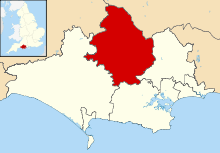Milton Abbas
| Milton Abbas | |
| Milton Abbas |
|
 Milton Abbas |
|
| Population | 755 |
|---|---|
| OS grid reference | ST806018 |
| District | North Dorset |
| Shire county | Dorset |
| Region | South West |
| Country | England |
| Sovereign state | United Kingdom |
| Police | Dorset |
| Fire | Dorset and Wiltshire |
| Ambulance | South Western |
| EU Parliament | South West England |
Coordinates: 50°48′55″N 2°16′34″W / 50.8152°N 2.2762°W
Milton Abbas is a village and civil parish in the county of Dorset in South West England. It lies in the North Dorset administrative district, approximately 7 miles (11 km) south-west of the market town of Blandford Forum and 11 miles (18 km) north-east of Dorchester. In the 2011 census the civil parish had 263 dwellings,[1] 232 households and a population of 755.[2] The village is sometimes considered the first planned settlement in England.
In 1780, Joseph Damer, Lord Milton, the first Earl of Dorchester and owner of Milton Abbey, decided that the adjacent market town, Middleton, was disturbing his vision of rural peace. He commissioned architect Sir William Chambers and landscape gardener Capability Brown (both of whom had already worked on the Abbey building and grounds) to design a new village, Milton Abbas, in a wooded valley (Luccombe Bottom) to the south of the Abbey. Most of the existing villagers were relocated here, and the previous village was demolished and the site landscaped.
The original abbey and House is now Milton Abbey School, a co-educational independent school, with around 250 pupils.
Milton Manor is a Grade II Listed house on the east side of the village. It was originally built in the mid 19th century as a shooting lodge forming part of the Hambro Estate. It was enlarged in the early 20th century in the Arts and Crafts style.[3]
The village features on many picture postcards of rural Dorset. The 36 almost identical thatched cottages were intended to house two families each. They were built from cob and previously were painted yellow, with each house fronted by a lawn; originally a horse chestnut tree was planted between each dwelling.[4] Almshouses and a church were also provided for the new village, sited opposite each other. The almshouses were moved from the old town, where they had originally been built in 1674. The church, consecrated in 1786, is in Georgian Gothic style, with late 19th-century additions.[4]
Some house-names give clues to some of the original inhabitants of the village: baker, blacksmith, brewery, etc. Today the houses are white-washed, and the main street also features a public house (the Hambro Arms), a Post Office/shop, a now redundant school building, and a Weslyan chapel. In 1953 the original horse chestnut trees were judged unsafe and a danger to the houses and removed.[4] Above the eastern end of the valley, the village has been extended with more modern housing and other facilities, including a doctor's surgery.
18th-century street fair
Every two years, villagers recreate their historic country fair to celebrate the rebuilding of the present village over 225 years ago. The fair attracts thousands of visitors and has become one of Dorset's key summer events. The main street is closed to traffic, and residents and stall holders dress in 18th-century costume. The day includes traditional music and dancing, local crafts people, stalls and demonstrations, a Dorset farmers' market, children's entertainment, Morris dancing, and local food and ale.
References
- ↑ "Area: Milton Abbas (Parish). Dwellings, Household Spaces and Accommodation Type, 2011 (KS401EW)". Neighbourhood Statistics. Office for National Statistics. Retrieved 4 February 2015.
- ↑ "Area: Milton Abbas (Parish). Key figures for 2011 Census: Key Statistics". Neighbourhood Statistics. Office for National Statistics. Retrieved 8 December 2013.
- ↑ "Milton Manor Hotel, Milton Abbas". British Listed Buildings. Retrieved 29 June 2014.
- 1 2 3 Roland Gant (1980). Dorset Villages. Robert Hale Ltd. p. 86. ISBN 0 7091 8135 3.
External links
| Wikimedia Commons has media related to Milton Abbas. |
- Milton Abbey Church and Landscape
- Milton Abbey School
- Census data
- The old town of Middleton or Milton, and its destruction by Joseph Damer to create a large park

